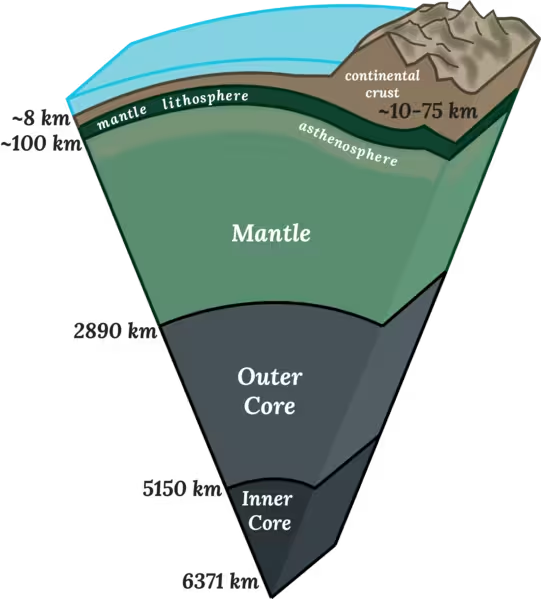Have you ever wondered what lies beneath your feet? 🌍 While we see the Earth’s surface every day—forests, mountains, oceans—what about what’s beneath all that? You might be surprised to know that Earth’s interior is more fascinating than any science fiction novel! Let’s take a fun journey into the Earth’s hidden layers and uncover some mind-blowing facts!
The Layers of the Earth
Imagine the Earth like an onion—layered, with each section having its own characteristics. There are four major layers: the crust, mantle, outer core, and inner core. Let’s break them down one by one.
1. The Crust: Earth’s Outer Skin 🧅
- Thickness: Think of this layer as the Earth’s skin. It’s incredibly thin compared to the other layers—only about 5 to 70 kilometers thick (that’s like the distance from one city to another!).
- Fun Fact: The crust under the oceans is thinner (called the oceanic crust), while the crust under continents is thicker (called the continental crust). So, if you’re standing on a beach, you’re right at the boundary between the two types!
- Crazy Thought: If the Earth were an apple, the crust would be thinner than the peel!
2. The Mantle: The Mighty Middle 🦸♀️
- Thickness: This layer is a whopping 2,900 kilometers thick! It’s the largest layer, making up about 84% of the Earth’s volume.
- Fun Fact: Even though it’s solid rock, the mantle flows—very slowly, like a super-thick milkshake. This movement is what causes tectonic plates (pieces of the crust) to move and create earthquakes and volcanoes.
- Mantle Magic: The mantle is where diamonds are born! 💎 These precious gems form under high pressure and temperatures deep within the Earth and are then brought closer to the surface by volcanic activity.
3. The Outer Core: Liquid Metal Soup 🥣
- Thickness: About 2,200 kilometers.
- Fun Fact: Unlike the mantle, the outer core is completely liquid! It’s mostly made of molten iron and nickel.
- Earth’s Dynamo: This liquid layer is constantly in motion, and it’s responsible for creating Earth’s magnetic field. Yep, the same magnetic field that protects us from harmful solar radiation and helps guide compass needles! Without the outer core, we’d be in trouble.
4. The Inner Core: Solid Superball of Heat 🥵
- Thickness: About 1,250 kilometers in radius.
- Fun Fact: Even though it’s as hot as the surface of the Sun (around 5,500°C), the inner core is solid because the pressure is so immense that the atoms are forced tightly together.
- Strange but True: The inner core is growing very slowly! Each year, it gets about a millimeter bigger as the outer core cools and solidifies. Eventually, billions of years from now, the Earth’s core could become entirely solid.
Fun Earth Facts
- Deepest Hole Ever Dug: Humans have only scratched the surface! The deepest hole ever dug is the Kola Superdeep Borehole in Russia, which reached about 12 kilometers (7.5 miles) into the crust—barely making it through the first layer!
- Dancing Continents: The Earth’s crust is broken into massive pieces called tectonic plates, which move around slowly (a few centimeters per year). Over millions of years, continents drift, creating new oceans and mountains. Once upon a time, all the continents were joined together in a supercontinent called Pangaea. Imagine if the Earth still looked like that today!
- Volcanic Birth: Most volcanoes on Earth are born at the boundaries of tectonic plates. When the plates move, they create cracks in the crust, allowing molten rock from the mantle to escape to the surface—boom! A volcano is born.
- Magnetic Reversal: Earth’s magnetic field has reversed many times in the past, meaning the North and South magnetic poles have switched places! Scientists believe we may be due for another flip in the future, but don’t worry, this process takes thousands of years.
What Lies Beneath Us?
Although we’ve never been able to visit the inner layers of the Earth, scientists have learned a lot through indirect means. By studying seismic waves from earthquakes, they’ve mapped out these layers—pretty clever, right? Think of it like using X-rays to see inside your body.

Why Should You Care?
Understanding Earth’s interior helps us predict natural disasters like earthquakes and volcanic eruptions, explore for resources like oil and gas, and learn more about how our planet evolved over billions of years. Plus, it’s just super cool to think about how the ground beneath you is moving, molten, and packed with mystery!
So next time you’re standing on solid ground, remember, there’s a whole world beneath your feet! From the crust you walk on to the blazing-hot inner core, Earth is an incredible planet full of surprises. Keep exploring, stay curious, and who knows—you might discover something new about our home!
Got more questions about Earth’s interior? Drop them in the comments! Let’s keep the conversation going!


Comments are closed